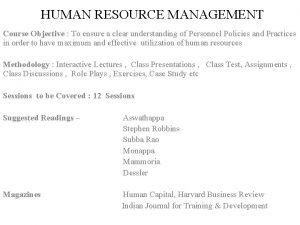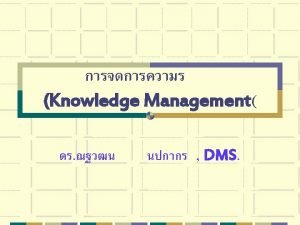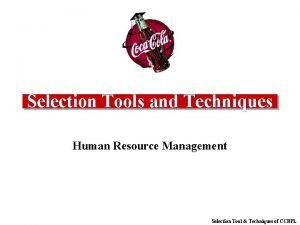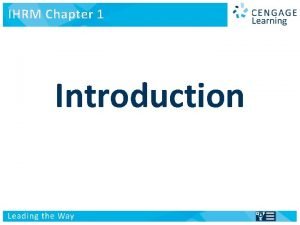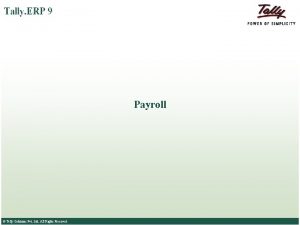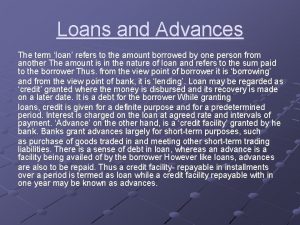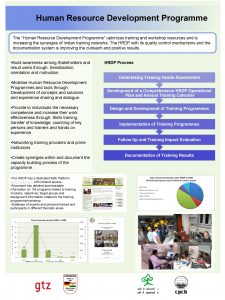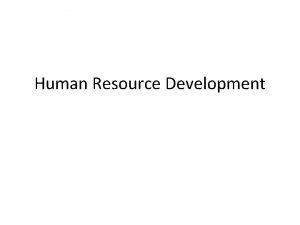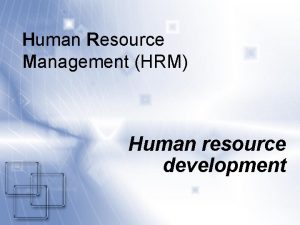Advances in Human Resource Development and Management Course


























- Slides: 26

Advances in Human Resource Development and Management Course Code: MGT 712 Lecture 29

Recap of Lecture 28 • • Payoff of Training Why Do HRD Programs Fail to Add Value? HRD Process Model Effectiveness HRD Evaluation Purposes of Evaluation Models and Frameworks of Evaluation Comparing Evaluation Frameworks Lecture 29 2

Learning Objectives: Lecture 29 • Data Collection for HRD Evaluation • Data Collection Methods • Advantages and Limitations of Various Data Collection Methods • Choosing Data Collection Methods • Type of Data Used/Needed • Use of Self-Report Data • Research Design • Ethical Issues Concerning Evaluation Research Lecture 29 3

Data Collection for HRD Evaluation efforts require the collection of data to provide decision makers with facts and judgments upon which they can base their decisions. Three important aspects of providing information for HRD evaluation include: – Data Collection Methods – Types of Data – Self-report Data Lecture 29 4

Data Collection Methods – Interviews – Questionnaires – Direct observation – Written tests – Simulation/Performance tests – Archival performance data Lecture 29 5

Interviews Advantages: • Flexible • Opportunity for clarification • Depth possible • Personal contact Limitations: • High reactive effects • High cost • Face-to-face threat potential • Labor intensive • Trained interviewers needed Lecture 29 6

Questionnaires Advantages: • Low cost to administer • Anonymity possible • Honesty increased if anonymous • Respondent sets the pace • Variety of options Limitations: • Possible inaccurate data • On-job responding conditions not controlled • Uncontrolled return rate Lecture 29 7

Direct Observation Advantages: • Nonthreatening • Excellent way to measure behavior change Limitations: • Possibly disruptive • Reactive effects are possible • May be unreliable • Need trained observers Lecture 29 8

Written Tests Advantages: • Low purchase cost • Easily administered • Readily scored • Quickly processed • Wide sampling possible Limitations: • May be threatening • Possibly no relation to job performance • Measures only cognitive learning • Reliance on norms may distort individual performance Lecture 29 9

Simulation/Performance Tests Advantages: • Reliable • Objective • Close relation to job performance • Includes cognitive, psychomotor and affective domains Limitations: • Time consuming • Simulations often difficult to create • High costs of development and use Lecture 29 10

Archival Performance Data Advantages: • Reliable • Objective • Job-based • Easy to review • Minimal reactive effects Limitations: • Lack of knowledge of criteria for keeping/ discarding records • Information system discrepancies • Indirect • Need conversion to usable from • Records prepared for other purposes Lecture 29 11

Choosing Data Collection Methods • Reliability Consistency of results, and freedom from error and bias in a data collection method • Validity Does the data collection method actually measure what we want it to measure? • Practicality Does it make sense in terms of the resources used to get the data? Lecture 29 12

Type of Data Used/Needed • Individual performance • Systemwide performance • Economic performance Lecture 29 13

Individual Performance Data • Individual performance data emphasize the individual trainee’s knowledge and behaviors. – Test scores – Performance quantity, quality, and timeliness – Attendance records – Attitudes Lecture 29 14

Systemwide Performance Data System wide performance data concern the team, division, or business unit in which the HRD program was conducted and could include data concerning the entire organization. – Productivity – Scrap/rework rates – Customer satisfaction levels – On-time performance levels – Quality rates and improvement rates Lecture 29 15

Economic Data • Economic data report the financial and economic performance of the organization or unit – – – Profits Product liability claims Avoidance of penalties Market share Competitive position Return on investment (ROI) A complete evaluation effort is likely to include all three types of data. Lecture 29 16

Use of Self-Report Data • Most commonly used data • Collected for personality, attitude, and perception • Problems: Mono-method bias If both reports pre-test and post-test come from the same source at the same time (after training) the conclusions may be questionable. Socially desirable responses Respondents may report what they think the researcher or boss wants to hear rather than the truth. Fearful to admit that they leaned nothing Response Shift Bias Respondents’ perspectives of their skills before training change during the training program and affect their after training assessment. • Relying on self-report data only may be problematic Lecture 29 17

Research Design Research design is a plan for conducting an evaluation study. • Research design is critical to HRD evaluation. • It specifies in advance: – The expected results of the study – The methods of data collection to be used – How the data will be analyzed Lecture 29 18

Research Design If outcomes are measured at all, they are only collected after the training program has been completed. – Such one-shot approach may not capture real changes that have occurred as a result of training – We cannot be certain that outcomes attained were due to the training. Lecture 29 19

Experimental Design: Pretest-Posttest with Control Group • Pretest and Posttest Including both pretest and posttest allows the trainer to see what has changed after the training. • Control group A group of employees similar to those who receive training, yet who don’t receive training. This group receives the same evaluation measures to make a comparison of their scores. • Random assignment to treatment and control groups so trainees have similar characteristics This four group design is the minimum acceptable research design for training/HRD evaluation efforts It controls the effects of pretest and prior knowledge. Lecture 29 20

Experimental Design: Pretest-Posttest with Control Group • Time series design Allows the trainer to observe patterns in individual performance. • Sample size Number of people providing data for a training evaluation is often low than what is recommended for statistical analysis. As a bare minimum, the training and control groups each need at least thirty individuals to have even a moderate chance of obtaining statistically significant results. Lecture 29 21

Ethical Issues Concerning Evaluation Research • Confidentiality When confidentiality is ensured, employees would be more willing to participate • Informed Consent Some evaluations are monitored so that employees know the potential risks and benefits informed consent motivates researchers to treat the participants fairly, it may improve the effectiveness of training by providing complete information. • Withholding Training When results of training are used for raises or promotions, it seems unfair to place employees in control groups just for the purpose of evaluation. • Use of deceptions When an investigator feels a study would yield better results if an employee did not realize they were on an evaluation study. • Pressure to produce positive results When Trainers are under pressure to make sure results of the evaluation demonstrates that the training was effective Lecture 29 22

HRD Evaluation Steps 1. Analyze needs. 2. Determine explicit evaluation strategy. 3. Insist on specific and measurable training objectives. 4. Obtain participant reactions. 5. Develop criterion measures/instruments to measure results. 6. Plan and execute evaluation strategy. Lecture 29 23

Summary of Lecture 29 • Data Collection for HRD Evaluation • Data Collection Methods • Advantages and Limitations of Various Data Collection Methods • Choosing Data Collection Methods • Type of Data Used/Needed • Use of Self-Report Data • Research Design • Ethical Issues Concerning Evaluation Research Lecture 29 24

Reference books Human Resource Development: Foundation, Framework and Application Jon M. Werner and Randy L. De. Simone: Cengage Learning, New Delhi Lecture 29 25

Thank you! Lecture 29 26
 Human resource management course objectives
Human resource management course objectives Time management in human resource management
Time management in human resource management Retail organisation
Retail organisation Role of personnel management
Role of personnel management Human resource development plan for deped
Human resource development plan for deped Human resource development framework
Human resource development framework Human resource management question paper 2020
Human resource management question paper 2020 Human resource development council of south africa
Human resource development council of south africa Hr practices in nepal
Hr practices in nepal Hr strategy map
Hr strategy map Framework of hrd
Framework of hrd Strategic human resource
Strategic human resource Human resources and job design
Human resources and job design Payroll cycle activities
Payroll cycle activities Recruitment and selection in human resource management
Recruitment and selection in human resource management Selection tools in hrm
Selection tools in hrm Difference between domestic hrm and ihrm
Difference between domestic hrm and ihrm Payroll in tally
Payroll in tally What is long term loans and advances
What is long term loans and advances Global oncology trends 2017 advances complexity and cost
Global oncology trends 2017 advances complexity and cost Cna chapter 8 human needs and human development
Cna chapter 8 human needs and human development Chapter 8 human needs and human development
Chapter 8 human needs and human development Project human resource management pmbok ppt
Project human resource management pmbok ppt Project human resource management pmbok
Project human resource management pmbok Important of human resource management
Important of human resource management Human resource management in restaurants
Human resource management in restaurants Induction definition in hrm
Induction definition in hrm
